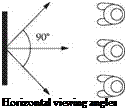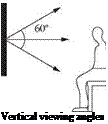Image brightness and obtainable contrast ratios are the fundamentals for image quality. As can be seen from the way in which the eye works, the image brightness and contrast ratio of the screen display must be selected based on the average adaptation level in the specific application. The higher the adaptation level, the brighter the image that is required. Adaptation level is a result of a number of different factors, including ambient light level, reflection factors on the surfaces in the field of vision, and luminance of different light sources in the field of vision. Given these variables, there are no standard recommendations for the required image brightness. However, as a general rule the image brightness should be at least at the level of the average luminance level in the field of vision, provided that a sufficient contrast ratio can be obtained. For simple displays (that is, those comprising simple graphic information), the contrast ratio should be at least 5:1. High-quality graphics with saturated colours and video images require a much higher contrast ratio. As a general rule the image contrast ratio should be at least 10:1.
 |
 |
FIGURE 4.9 Viewing angles.
FIGURE 4.10 Viewing distances.



